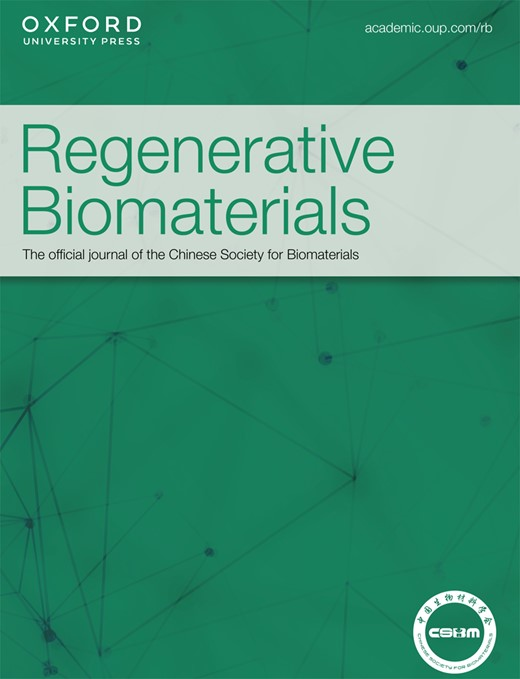重塑肿瘤免疫微环境的脂质/PLGA 纳米复合物用于结肠癌治疗
IF 5.6
1区 医学
Q1 MATERIALS SCIENCE, BIOMATERIALS
引用次数: 0
摘要
免疫检查点阻断疗法为肿瘤治疗提供了一种新策略,但细胞毒性T细胞浸润不足和肿瘤微环境中的免疫抑制导致疗效不理想。在此,我们报道了一种脂质/PLGA纳米复合物(RDCM),该复合物共同负载了光敏剂Ce6和吲哚胺2,3-二氧化酶(IDO)抑制剂1MT,以改善结肠癌的免疫治疗。精氨酸-甘氨酸-天冬氨酸(RGD)作为靶向分子通过 PEG 与 1,2-二硬脂酰-鞘氨醇-3-磷酸乙醇胺脂质共轭,程序性细胞死亡配体 1(PD-L1)肽抑制剂 DPPA 通过基质金属蛋白酶 2 敏感肽链固定在 PEG 的末端基团上。Ce6 和 1MT 被封装在 PLGA 纳米颗粒中。载药纳米颗粒与 RGD 和 DPPA 修饰的脂质和卵磷脂复合,形成脂质/PLGA 纳米络合物。当纳米复合物被递送到肿瘤中时,DPPA会被基质金属蛋白酶2敏感的肽链裂解释放,从而与PD-L1结合。RGD通过avβ3整合素促进了纳米复合物的细胞内化。660纳米激光照射Ce6产生的1O2诱导了强免疫原性细胞死亡。1MT 可抑制 IDO 的活性,减少肿瘤微环境中犬尿氨酸积累对细胞毒性 T 细胞的抑制。RDCM促进了树突状细胞的成熟,抑制了IDO的活性,并显著招募了CT26肿瘤小鼠体内肿瘤浸润细胞毒性T细胞的比例,引发了强大的免疫记忆效应,从而有效阻止了肿瘤转移。结果表明,具有 IDO 和 PD-L1 双重抑制作用的 RDCM 是一种很有前景的结肠癌靶向光免疫治疗平台。本文章由计算机程序翻译,如有差异,请以英文原文为准。
A lipid/PLGA nanocomplex to reshape tumor immune microenvironment for Colon cancer therapy
Immune checkpoint blockade therapy provides a new strategy for tumor treatment, however, the insufficient infiltration of cytotoxic T cells and immunosuppression in tumor microenvironment lead to unsatisfied effects. Herein, we reported a lipid/PLGA nanocomplex (RDCM) co-loaded with the photosensitizer Ce6 and the indoleamine 2,3-dioxygenase (IDO) inhibitor 1MT to improve immunotherapy of colon cancer. Arginine-glycine-aspartic acid (RGD) as the targeting moiety was conjugated on 1,2-distearoyl-snglycero-3-phosphoethanolamine lipid via PEG, and programmed cell death-ligand 1 (PD-L1) peptide inhibitor DPPA was immobilized on the terminal group of PEG via matrix metalloproteinase 2 sensitive peptide linker. The Ce6 and 1MT were encapsulated in PLGA nanoparticles. The drug loaded nanoparticles were composited with RGD and DPPA modified lipid and lecithin to form lipid/PLGA nanocomplexes. When the nanocomplexes were delivered to tumor, DPPA was released by the cleavage of a matrix metalloproteinase 2-sensitive peptide linker for PD-L1 binding. RGD facilitated the cellular internalization of nanocomplexes via avβ3 integrin. Strong immunogenic cell death was induced by 1O2 generated from Ce6 irradiation under 660 nm laser. 1MT inhibited the activity of IDO and reduced the inhibition of cytotoxic T cells caused by kynurenine accumulation in the tumor microenvironment. The RDCM facilitated the maturation of dendritic cells, inhibited the activity of IDO, and markedly recruited the proportion of tumor-infiltrating cytotoxic T cells in CT26 tumor-bearing mice, triggering a robust immunological memory effect, thus effectively preventing tumor metastasis. The results indicated that the RDCM with dual IDO and PD-L1 inhibition effects is a promising platform for targeted photoimmunotherapy of colon cancer.
求助全文
通过发布文献求助,成功后即可免费获取论文全文。
去求助
来源期刊

Regenerative Biomaterials
Materials Science-Biomaterials
CiteScore
7.90
自引率
16.40%
发文量
92
审稿时长
10 weeks
期刊介绍:
Regenerative Biomaterials is an international, interdisciplinary, peer-reviewed journal publishing the latest advances in biomaterials and regenerative medicine. The journal provides a forum for the publication of original research papers, reviews, clinical case reports, and commentaries on the topics relevant to the development of advanced regenerative biomaterials concerning novel regenerative technologies and therapeutic approaches for the regeneration and repair of damaged tissues and organs. The interactions of biomaterials with cells and tissue, especially with stem cells, will be of particular focus.
 求助内容:
求助内容: 应助结果提醒方式:
应助结果提醒方式:


